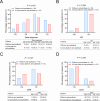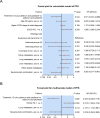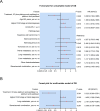The outcome of advanced and recurrent cervical cancer patients treated with first-line platinum and paclitaxel with or without indication for immune checkpoint inhibitors: the comparative study
- PMID: 39394089
- PMCID: PMC11468096
- DOI: 10.1186/s12885-024-12989-x
The outcome of advanced and recurrent cervical cancer patients treated with first-line platinum and paclitaxel with or without indication for immune checkpoint inhibitors: the comparative study
Abstract
Objective: Immune checkpoint inhibitor (ICI) therapy activates the immune system to recognize and eliminate cancer cells that have escaped surveillance. This study aimed to compare the treatment outcome of advanced and recurrent cervical cancer patients treated with first-line platinum and paclitaxel with or without ICI.
Methods: Data from 69 advanced and recurrent cervical cancer patients treated with first-line ICI plus platinum and paclitaxel (N = 33) or first-line platinum and paclitaxel (N = 36) were reviewed between March 2020 and January 2023 in this retrospective study. Patients chose treatment based on the actual disease condition, patient willingness, and medical advice. Additionally, objective response rate (ORR), disease control rate (DCR), progression-free survival (PFS), and overall survival (OS) were calculated, and adverse events were gained.
Results: There was no difference in baseline data between patients receiving the two different treatments (all P > 0.05). Complete response rate (18.2% vs. 8.3%; P = 0.294), ORR (48.5% vs. 30.6%; P = 0.127), and DCR (81.8% vs. 72.2%; P = 0.345) tended to ascend in patients treated with ICI plus platinum and paclitaxel compared to those treated with platinum and paclitaxel, although there was no statistical significance. In patients treated with ICI plus platinum and paclitaxel, the median PFS was 10.3 months and the median OS was not reached. Meanwhile, the median PFS and OS were 7.7 and 16.9 months in patients treated with platinum and paclitaxel. PFS (P = 0.036) and OS (P = 0.033) were increased in patients treated with ICI plus platinum and paclitaxel versus those treated with platinum and paclitaxel, which was verified by multivariate Cox regression analyses (both P < 0.05). No difference was observed in the occurrence of adverse events between patients receiving the two different treatments (all P > 0.05).
Conclusion: First-line ICI plus platinum and paclitaxel yields better treatment responses, longer survival, and non-differential adverse events versus first-line platinum and paclitaxel in advanced and recurrent cervical cancer patients.
Keywords: Advanced and recurrent cervical cancer; Immune checkpoint inhibitors; Safety; Survival; Treatment response.
© 2024. The Author(s).
Conflict of interest statement
The authors declare no competing interests.
Figures





Similar articles
-
Nab-paclitaxel plus platinum versus paclitaxel plus platinum as first-line therapy in patients with metastatic or recurrent cervical cancer.J Cancer Res Clin Oncol. 2024 Jun 25;150(6):321. doi: 10.1007/s00432-024-05825-z. J Cancer Res Clin Oncol. 2024. PMID: 38914827 Free PMC article.
-
Single or combined immune checkpoint inhibitors compared to first-line platinum-based chemotherapy with or without bevacizumab for people with advanced non-small cell lung cancer.Cochrane Database Syst Rev. 2020 Dec 14;12(12):CD013257. doi: 10.1002/14651858.CD013257.pub2. Cochrane Database Syst Rev. 2020. Update in: Cochrane Database Syst Rev. 2021 Apr 30;4:CD013257. doi: 10.1002/14651858.CD013257.pub3. PMID: 33316104 Free PMC article. Updated.
-
Single or combined immune checkpoint inhibitors compared to first-line platinum-based chemotherapy with or without bevacizumab for people with advanced non-small cell lung cancer.Cochrane Database Syst Rev. 2021 Apr 30;4(4):CD013257. doi: 10.1002/14651858.CD013257.pub3. Cochrane Database Syst Rev. 2021. PMID: 33930176 Free PMC article.
-
A phase II trial of paclitaxel plus biweekly cetuximab for patients with recurrent or metastatic head and neck cancer previously treated with both platinum-based chemotherapy and anti-PD-1 antibody.ESMO Open. 2024 Jun;9(6):103476. doi: 10.1016/j.esmoop.2024.103476. Epub 2024 Jun 3. ESMO Open. 2024. PMID: 38833968 Free PMC article. Clinical Trial.
-
Efficacy and safety of gemcitabine/nab-paclitaxel combined with anlotinib and PD-1 inhibitors as a first-line treatment for advanced pancreatic cancer.Int Immunopharmacol. 2024 Sep 30;139:112635. doi: 10.1016/j.intimp.2024.112635. Epub 2024 Jul 12. Int Immunopharmacol. 2024. PMID: 39002522
Cited by
-
The promise of PD1/PDL1 targeted immunotherapy in locally advanced cervical cancer: a game-changer for patients outcome?Front Immunol. 2025 May 13;16:1573576. doi: 10.3389/fimmu.2025.1573576. eCollection 2025. Front Immunol. 2025. PMID: 40433369 Free PMC article. Review.
References
-
- Menderes G, Black J, Schwab CL, Santin AD. Immunotherapy and targeted therapy for cervical cancer: an update. Expert Rev Anticancer Ther. 2016;16(1):83–98. - PubMed

